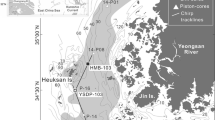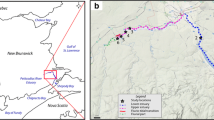Abstract
Fluid muds are common in estuarine environments, but their ancient examples have rarely been documented due to poor comprehension of their depositional processes and characteristics. Mudstone layers in the tidally-influenced channel sequences of the middle McMurray Formation are examined in detail through microscopic observations and interpreted on the basis of recent advances in the understanding of flow dynamics of high mud-concentration flows. The mudstone layers, < 1 to 25 mm thick, are classified into three microfacies. Structureless mudstone (Microfacies 1) consists mainly of clay particles with randomly dispersed coarse grains (coarse silt to fine sand). It represents cohesive mud flows with sufficient cohesive forces to support coarse grains (quasi-laminar plug flow). Silt-streaked mudstone (Microfacies 2) is similar to Microfacies 1 in texture, but contains discontinuous streaks of coarse-silt to very-fine-sand grains. It is interpreted as being also deposited by cohesive fluid muds. The silt streaks are, however, suggestive of the presence of weak turbulence under the cohesive plug (upper transitional plug flow). Heterolithic laminated mudstone (Microfacies 3) is characterized by alternations of very thin, silt and clay laminae, which are either parallel or low-angle cross-laminated. It is interpreted as the deposits of low-amplitude bed-waves formed in lower transitional plug flows. These microfacies reflect a range of flow phases of fluid muds, which changed as flow velocities and suspended sediment concentrations fluctuated with tidal cycles. Repeated vertical changes of microfacies are suggestive of an ideal sequence of fluid muds formed during tidal acceleration and deceleration. The sequence comprising microfacies 3, 2 and 1 in ascending order represents deposition from lower transitional plug flows through upper transitional plug flows to quasi-laminar plug flows as suspended sediment concentrations increase with flow deceleration. That of the reversed order of microfacies reflects the reversed change in flow types during acceleration. These results provide the basis for recognizing fluid-mud deposits and tidal signatures in ancient estuarine sequences.
Similar content being viewed by others
References
Alberta Energy and Utilities Board, 2007, Alberta’s Energy Reserves 2006 and Supply/Demand Outlook 2007–2016. AEUB ST98-2007, Calgary, 218 p.
Baas, J.H. and Best, J.L., 2002, Turbulence modulation in clay-rich sediment-laden flows and some implications for sediment deposition. Journal of Sedimentary Research, 72, 336–340.
Baas, J.H., Best, J.L., and Peakall, J., 2011, Depositional processes, bed-form development and hybrid bed formation in rapidly decelerated cohesive (mud-sand) sediment flows. Sedimentology, 58, 1953–1987.
Baas, J.H., Best, J.L., and Peakall, J., 2016, Predicting bedforms and primary current stratification in cohesive mixtures of mud and sand. Journal of the Geological Society, 173, 12–45.
Baas, J.H., Best, J.L., Peakall, J., and Wang, M., 2009, A phase diagram for turbulent, transitional, and laminar clay suspension flows. Journal of Sedimentary Research, 79, 162–183.
Cant, D.J., 1996, Sedimentological and sequence stratigraphic organization of a foreland clastic wedge, Mannville Group, Western Canada Basin. Journal of Sedimentary Research, 66, 1137–1147. https://doi.org/10.1306/D42684C3-2B26-11D7-8648000102C1865D
Crerar, E.E. and Arnott, R.W.C., 2007, Facies distribution and strati-graphic architecture of the Lower Cretaceous McMurray Formation, Lewis Property, northeastern Alberta. Bulletin of Canadian Petroleum Geology, 55, 99–124.
Dalrymple, R.W. and Choi, K.S., 2007, Morphologic and facies trends through the fluvial-marine transition in tide-dominated depositional systems: a schematic framework for environmental and sequence-stratigraphic interpretation. Earth-Science Reviews, 81, 135–174.
Flach, P.D., 1984, Oil Sands Geology—Athabasca deposit north. Alberta Research Council, Edmonton, 31 p.
Flach, P.D. and Mossop, G.D., 1985, Depositional environments of Lower Cretaceous McMurray Formation, Athabasca oil sands, Alberta. American Association of Petroleum Geologists Bulletin, 69, 1195–1207. https://doi.org/10.1306/AD462BAF-16F7-11D7-8645000102C1865D
Ghadeer, S.G. and Macquaker, J.H.S., 2011, Sediment transport processes in an ancient mud-dominated succession: a comparison of processes operating in marine offshore settings and anoxic basinal environments. Journal of the Geological Society, 168, 1121–1132.
Hayes, B.J.R., Christopher, J.E., Rosenthal, L., Los, G., McKercher, B., Minken, D., Tremblay, Y.M., and Fennell, J., 1994, Cretaceous Mannville Group of the Western Canada sedimentary basin. In: Mossop, G.D. and Shetsen, I. (eds.), Geological Atlas of the Western Canada Sedimentary Basin. Canadian Society of Petroleum Geologists and Alberta Research Council, Special Report, 4, p. 317–334.
Hein, F.J., 2015, The Cretaceous McMurray oil sands, Alberta, Canada: a world-class, tidally influenced fluvial-estuarine system—an Alberta government perspective. In: Ashworth, P.J., Best, J.L., and Parsons, D.R. (eds.), Fluvial-Tidal Sedimentology. Developments in Sedimentology, 68, p. 561–621. https://doi.org/10.1016/B978-0-444-63529-7.00018-3
Hein, F.J. and Cotterill, D.K., 2006, The Athabasca oil sands—a regional geological perspective, Fort McMurray area, Alberta, Canada. Natural Resources Research, 15, 85–102.
Hein, F.J., Cotterill, D.K., and Berhane, H., 2000, An atlas of lithofacies of the McMurray Formation, Athabasca oil sands deposit, northeastern Alberta: surface and subsurface. Earth Sciences Report 2000-07, Alberta Energy and Utilities Board/Alberta Geological Survey, Edmonton, 217 p.
Hovikoski, J., Therkelsen, J., Nielsen, L.H., Bojesen-Koefoed, J.A., Nytoft, H.P., Petersen, H.I., Abatzis, I., Tuan, H.A., Phuong, B.T.N., Dao, C.V., and Fyhn, M.B.W., 2016, Density-flow deposition in a fresh-water lacustrine rift basin, Paleogene Bach Long Vi Graben, Vietnam. Journal of Sedimentary Research, 86, 982–1007.
Hubbard, S.M., Smith, D.G., Nielsen, H., Leckie, D.A., Fustic, M., Spencer, R.J., and Bloom, L., 2011, Seismic geomorphology and sedimentology of a tidally influenced river deposit, Lower Cretaceous Athabasca oil sands, Alberta, Canada. American Association of Petroleum Geologists Bulletin, 95, 1123–1145.
Ichaso, A.A. and Dalrymple, R.W., 2009, Tide- and wave-generated fluid mud deposits in the Tilje Formation (Jurassic), offshore Norway. Geology, 37, 539–542.
Jo, H.R. and Ha, C.G., 2013a, Stratigraphic architecture of fluvial deposits of the Cretaceous McMurray Formation, Athabasca oil sands, Alberta, Canada. Geosciences Journal, 17, 417–427.
Jo, H.R. and Ha, C.G., 2013b, Basal water-bearing zone of the oil-sands deposits of the Cretaceous McMurray Formation at Christina Lake, Alberta, Canada. Geosciences Journal, 17, 445–453.
Kirby, R. and Parker, W.R., 1983, Distribution and behavior of fine sediment in the Severn Estuary and inner Bristol Channel, U.K. Canadian Journal of Fisheries and Aquatic Sciences, 40, 83–95.
La Croix, A.D. and Dashtgard, S.E., 2015, A synthesis of depositional trends in intertidal and upper subtidal sediments across the tidal-fluvial transition in the Fraser River, Canada. Journal of Sedimentary Research, 85, 682–698.
La Croix, A.D., Dashtgard, S.E. and MacEachern, J.A., 2019, Using a modern analogue to interpret depositional position in ancient fluvial-tidal channels: example from the McMurray Formation, Canada. Geoscience Frontiers, 10, 2219–2238.
Leckie, D.A. and Smith, D.G., 1992, Regional setting, evolution, and depositional cycles of the Western Canada foreland basin. In: Macqueen, R.W. and Leckiem D.A. (eds.), Foreland Basins and Fold Belts. American Association of Petroleum Geologists Memoir, 55, p. 9–46.
Mackay, D.A. and Dalrymple, R.W., 2011, Dynamic mud deposition in a tidal environment: the record of fluid-mud deposition in the Cretaceous Bluesky Formation, Alberta, Canada. Journal of Sedimentary Research, 81, 901–920.
McAnally, W.H., Friedrichs, C., Hamilton, D., Hayter, E., Shrestha, P., Rodriguez, H., Sheremet, A., and Teeter, A., 2007, Management of fluid mud in estuaries, bays, and lakes. I: present state of understanding on character and behavior. Journal of Hydraulic Engineering, 133, 9–22.
Mossop, G.D. and Flach, P.D., 1983, Deep channel sedimentation in the Lower Cretaceous McMurray Formation, Athabasca Oil sands, Alberta. Sedimentology, 30, 493–509.
Musial, G., Reynaud, J.-Y., Gingras, M.K., Féniès, H., Labourdette, R., and Parize, O., 2012, Subsurface and outcrop characterization of large tidally influenced point bars of the Cretaceous McMurray Formation (Alberta, Canada). Sedimentary Geology, 279, 156–172.
Nardin, T.R., Feldman, H.R., and Carter, B.J., 2013, Stratigraphic architecture of a large-scale point-bar complex in the McMurray Formation: Syncrude’s Mildred Lake Mine, Alberta, Canada. In: Hein, F.J., Leckie, D., Larter, S., and Suter, J.R. (eds.), Heavy-oil and Oil-sand Petroleum Systems in Alberta and Beyond. American Association of Petroleum Geologists Studies in Geology, 64, p. 273–311. https://doi.org/10.1306/13371583St643555
Plint, A.G., 2014, Mud dispersal across a Cretaceous prodelta: storm-generated, wave-enhanced sediment gravity flows inferred from mudstone microtexture and microfacies. Sedimentology, 61, 609–647.
Ranger, M.J. and Pemberton, S.G., 1997, Elements of a stratigraphic framework for the McMurray Formation in south Athabasca area, Alberta. In: Pemberton, S.G. and James, D.P. (eds.), Petroleum Geology of the Cretaceous Mannville Group, Western Canada. Canadian Society of Petroleum Geologists Memoir, 18, p. 263–291.
Ross, M.A. and Mehta, A.J., 1989, On the mechanics of lutoclines and fluid mud. Journal of Coastal Research, 5, 51–61.
Shinn, Y.J., Lee, H.S., Kwon, Y.K., and Kwak, W.J., 2014, Lithofacies distribution and depositional environment in the Lower Cretaceous McMurray Formation, BlackGold Lease, northern Alberta: implications for geometry and distribution of oil sand reservoirs. Geosciences Journal, 18, 325–337.
Soyinka, O.A. and Slatt, R.M., 2008, Identification and micro-stratigraphy of hyperpycnites and turbidites in Cretaceous Lewis Shale, Wyoming. Sedimentology, 88, 1117–1133.
Stockmal, G.S., Cant, D.J., and Bell, J.S., 1992, Relationship of the stratigraphy of the Western Canada foreland basin to Cordilleran tectonics: insights from geodynamic models. In: Macqueen, R.W. and Leckie, D.A. (eds.), Foreland Basins and Fold Belts. American Association of Petroleum Geologists Memoir, 55, p. 107–124.
Sumner, E.J., Talling, P.J., and Amy, L.A., 2009, Deposits of flows transitional between turbidity current and debris flow. Geology, 37, 991–994.
Traykovski, P., Geyer, WR., Irish, J.D., and Lynch, J.F., 2000, The role of wave-induced density-driven fluid mud flows for cross-shelf transport on the Eel River continental shelf. Continental Shelf Research, 20, 2113–2140.
Wang, Z. and Larsen, P., 1994, Turbulent structure of water and clay suspensions with bed load. Journal of Hydraulic Engineering, 120, 577–600.
Wightman, D.M. and Pemberton, S.G., 1997, The Lower Cretaceous (Aptian) McMurray Formation: an overview of the Fort McMurray area, northeastern Alberta. In: Pemberton, S.G. and James, D.P. (eds.), Petroleum Geology of the Cretaceous Mannville Group, Western Canada. Canadian Society of Petroleum Geologists Memoir, 18, p. 312–344.
Yawar, Z. and Schieber, J., 2017, On the origin of silt laminae in laminated shales. Sedimentary Geology, 360, 22–34.
Acknowledgments
This research was supported by Basic Science Research Program through the National Research Foundation of Korea (NRF) funded by the Ministry of Education (2017R1D1A1B03034796).
Author information
Authors and Affiliations
Corresponding author
Additional information
Publisher’s Note
Springer Nature remains neutral with regard to jurisdictional claims in published maps and institutional affiliations.
Rights and permissions
About this article
Cite this article
Oh, J., Jo, H.R. Tidally-influenced deposition and microfacies sequences of fluid muds: Early Cretaceous McMurray Formation, Alberta, Canada. Geosci J 25, 749–762 (2021). https://doi.org/10.1007/s12303-021-0008-4
Received:
Accepted:
Published:
Issue Date:
DOI: https://doi.org/10.1007/s12303-021-0008-4




